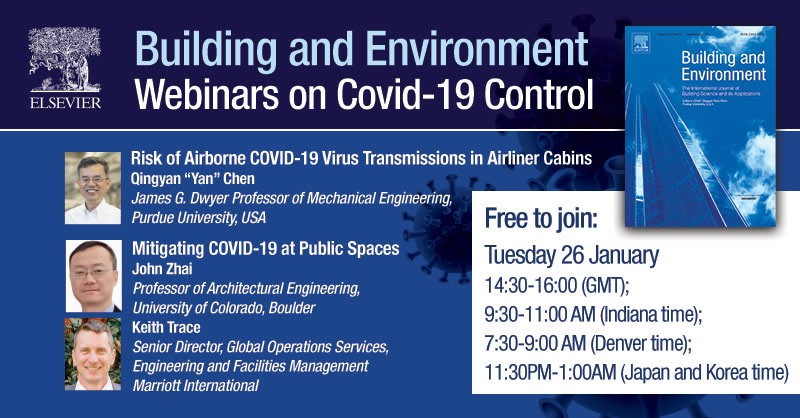Free webinar series on COVID-19 control
Online Webinar

There will be 2 presentations in this first webinar, followed by a Question and Discussion session:
Risk of Airborne COVID-19 Virus Transmissions in Airliner Cabins, presented by Qingyan “Yan” Chen, James G. Dwyer Professor of Mechanical Engineering, Purdue University, USA
Abstract: Deadly airborne infectious diseases appear every few years, such as SARS in 2003, H1N1‐A influenza in 2010, and COVID‐19 in 2020. The diseases could be brought from one country to another by airplanes and in many cases infection could occur in airplane cabins. This seminar will show how to model airborne mode of COVID-19 transmission caused by coughing, talking, and breathing from an index patient. Then we will use the flight from Hong Kong to China in 2003 as an example to illustrate how an index patient of SARS could infect more than 20 fellow passengers in the airplane cabin. We believe that the ventilation system and the wake generated by a moving person played a role on the transmission. We will also discuss possible measures, such as wearing masks and changing ventilation systems, to mitigate infection risk caused by COVID-19.
Mitigating COVID-19 at Public Spaces, presented by John Zhai, Professor of Architectural Engineering, University of Colorado, Boulder and Keith Trace, Senior Director, Global Operations Services, Engineering and Facilities Management, Marriott International
Abstract: Scientific research has shown that the SARS-CoV-2 virus is spread via aerosolized particles. The risk of airborne spread can be reduced via a layered approach which includes social distancing, wearing masks and improving air quality with ventilation and filtration. Public spaces such as restaurants and ballrooms exhibit special risk concerns due to large occupant density, complex systems and layouts, and no-mask-activities (e.g., at dining). This study used both computational fluid dynamics and field mock-up experiment to investigate the indoor virus transport characteristics and potential mitigation solutions. Special attention was given to the utilization and optimization of portable air purifiers. Scenarios without and with purifiers were examined and compared, upon which recommendations for mitigating indoor airborne virus transmission were delivered.
For more information please see here:https://www.journals.elsevier.com/building-and-environment/webinars or to register directly for this webinar please go here: https://researcheracademy.elsevier.com/workshop/b54c30d6-5806-47bc-bd20-89ebfa3ae704
